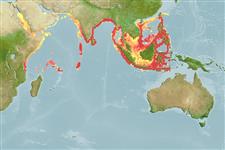Common names from other countries
Environment: milieu / climate zone / depth range / distribution range
Ecologia
marinhas; Água doce; estuarina demersal; anfídromo (Ref. 51243); intervalo de profundidade 10 - 961 m (Ref. 9494). Tropical; 25°N - 10°S, 32°E - 127°E
Indo-West Pacific: Malay Archipelago including Thailand, Viet Nam, the Philippines and Indonesia westward to seas and estuaries of India and Pakistan to the Red Sea (Ref. 9895).
Comprimento de primeira maturação / Tamanho / Peso / Idade
Maturity: Lm 10.8, range 9 - 12.2 cm
Max length : 45.0 cm TL macho/indeterminado; (Ref. 11298); common length : 25.0 cm TL macho/indeterminado; (Ref. 9895)
Espinhos dorsais (total) : 0; Raios dorsais (total) : 126 - 138; Espinhos anais: 0; Raios anais : 97 - 114; Vértebras: 57 - 66.
Adults live mainly in shallow muddy and sandy bottoms of the continental shelf, sometimes entering estuaries and tidal rivers (Ref. 1479, 48637). Usually deeply buried in the substrate during the day, but out and hunting at night (Ref. 48637). They feed mainly on benthic invertebrates. Marketed mostly fresh and frozen; also dried-salted (Ref. 9895).
Menon, A.G.K., 1977. A systematic monograph of the tongue soles of the genus Cynoglossus Hamilton-Buchanan (Pisces: Cynoglossidae). Smithson. Contrib. Zool. (238):1-129. (Ref. 5297)
Status na Lista Vermelha da UICN (Ref. 130435)
CITES (Ref. 128078)
Not Evaluated
Ameaça para os humanos
Harmless
Uso pelos humanos
Pescarias: espécies comerciais
Ferramentas
Relatórios especiais
Baixar XML
Fontes da internet
Estimates based on models
Preferred temperature (Ref.
115969): 8.8 - 18.2, mean 12.3 (based on 243 cells).
Índice de diversidade filogenética (Ref.
82804): PD
50 = 0.5000 [Uniqueness, from 0.5 = low to 2.0 = high].
Bayesian length-weight: a=0.01514 (0.00592 - 0.03870), b=3.00 (2.77 - 3.23), in cm Total Length, based on LWR estimates for this (Sub)family-body shape (Ref.
93245).
Nível Trófico (Ref.
69278): 3.5 ±0.37 se; based on food items.
Resiliência (Ref.
120179): médio(a), tempo mínimo de duplicação da população 1,4 - 4,4 anos (Fec = 360-35,926).
Fishing Vulnerability (Ref.
59153): Low to moderate vulnerability (35 of 100).
